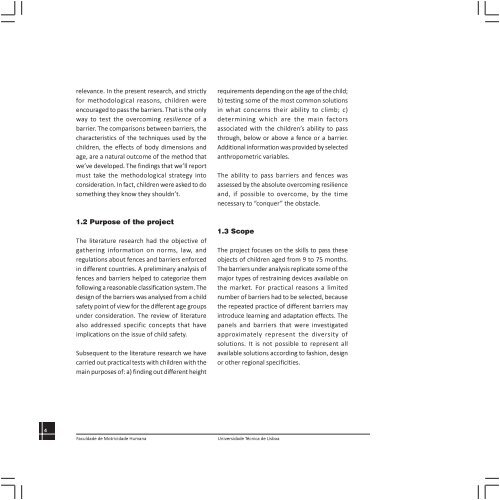Dimensions and Design of swimming pool fences and balcony - ANEC
Dimensions and Design of swimming pool fences and balcony - ANEC
Dimensions and Design of swimming pool fences and balcony - ANEC
Create successful ePaper yourself
Turn your PDF publications into a flip-book with our unique Google optimized e-Paper software.
elevance. In the present research, <strong>and</strong> strictly<br />
for methodological reasons, children were<br />
encouraged to pass the barriers. That is the only<br />
way to test the overcoming resilience <strong>of</strong> a<br />
barrier. The comparisons between barriers, the<br />
characteristics <strong>of</strong> the techniques used by the<br />
children, the effects <strong>of</strong> body dimensions <strong>and</strong><br />
age, are a natural outcome <strong>of</strong> the method that<br />
we’ve developed. The findings that we’ll report<br />
must take the methodological strategy into<br />
consideration. In fact, children were asked to do<br />
something they know they shouldn’t.<br />
requirements depending on the age <strong>of</strong> the child;<br />
b) testing some <strong>of</strong> the most common solutions<br />
in what concerns their ability to climb; c)<br />
determining which are the main factors<br />
associated with the children’s ability to pass<br />
through, below or above a fence or a barrier.<br />
Additional information was provided by selected<br />
anthropometric variables.<br />
The ability to pass barriers <strong>and</strong> <strong>fences</strong> was<br />
assessed by the absolute overcoming resilience<br />
<strong>and</strong>, if possible to overcome, by the time<br />
necessary to “conquer” the obstacle.<br />
1.2 Purpose <strong>of</strong> the project<br />
The literature research had the objective <strong>of</strong><br />
gathering information on norms, law, <strong>and</strong><br />
regulations about <strong>fences</strong> <strong>and</strong> barriers enforced<br />
in different countries. A preliminary analysis <strong>of</strong><br />
<strong>fences</strong> <strong>and</strong> barriers helped to categorize them<br />
following a reasonable classification system. The<br />
design <strong>of</strong> the barriers was analysed from a child<br />
safety point <strong>of</strong> view for the different age groups<br />
under consideration. The review <strong>of</strong> literature<br />
also addressed specific concepts that have<br />
implications on the issue <strong>of</strong> child safety.<br />
Subsequent to the literature research we have<br />
carried out practical tests with children with the<br />
main purposes <strong>of</strong>: a) finding out different height<br />
1.3 Scope<br />
The project focuses on the skills to pass these<br />
objects <strong>of</strong> children aged from 9 to 75 months.<br />
The barriers under analysis replicate some <strong>of</strong> the<br />
major types <strong>of</strong> restraining devices available on<br />
the market. For practical reasons a limited<br />
number <strong>of</strong> barriers had to be selected, because<br />
the repeated practice <strong>of</strong> different barriers may<br />
introduce learning <strong>and</strong> adaptation effects. The<br />
panels <strong>and</strong> barriers that were investigated<br />
approximately represent the diversity <strong>of</strong><br />
solutions. It is not possible to represent all<br />
available solutions according to fashion, design<br />
or other regional specificities.<br />
4<br />
Faculdade de Motricidade Humana<br />
Universidade Técnica de Lisboa
















